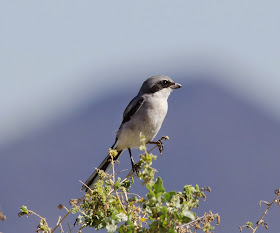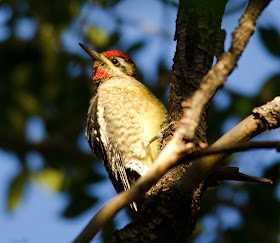Late last week, in a hastily planned birding road trip to Flagstaff, 4 of us made a 1 day trip to the Flagstaff, Arizona area for some great birding. I joined forces with 3 other extraordinary birders, Tommy DeBardeleben, Laurence Butler, and Mark Ochs. Rather sad to say, but I have not done much birding in this part of the state, and that is a shame as there are some awesome birds to be found at this high elevation. Glad I joined in on the trip as I discovered some really awesome spots for future trips.
Our first stop was at Rio de Flag near the Museum of Northern Arizona. Not a big spot by any means, but tucked away in a residential neighborhood. The prime target birds at this location? Cassin's Finches and Evening Grosbeaks. Neither one of these birds was a new bird for me this year as I have found more Cassin's finches this year than I thought possible and sure enough, it was one of the first birds that we found, keeping to themselves high in the pines. What I was more interested in was the Evening Grosbeak, a bird that I encountered for the first time in June of this year and have been wanting to see more. One can never have too many photos of this stunning bird. Alas, they too, did not want to meet me at eye level for photos, but maybe I have not yet won over their confidence.
Evening Grosbeak
Evening Grosbeaks
Evening Grosbeak
And since we happened to be close to a residential neighborhood, we had a 'murder' of American Crows congregating on one of the houses. (Yes, the term 'murder' is the collective name for a bunch of crows!)
A 'murder' of American Crows
From here, we headed to Ashurst Lake, which is another new spot and one that can harbor some rarities from time to time. While the lake had huge numbers of waterfowl, most of the birding here was with scopes from the distant shore line. However, a couple of species of bluebirds presented a consolation prize for photos. MOBLs and WEBLs (Mountain Bluebirds and Western Bluebirds) were evident in many places on this day and at this location we had both. I think the Mountain Bluebird has a little bit better camouflage with the blue sky than the Western Bluebirds.
Mountain Bluebird
Western Bluebird
Western Bluebird
As we were departing this great spot an adult Bald Eagle was posing as a sentinel in the dead branches of a pine a bit off the exit road. Always great to see this majestic bird and the symbol of the United States!
Bald Eagle
Our next spot was Mormon Lake which is a vast shallow lake especially when springtime snow melts fill up most of it. This weekend, it was fairly dry, but as we drove from points around this lake, we were noticing Lewis's Woodpeckers which are always a treat and definitely not unexpected. This is their habitat, however, we were astounded by the sheer numbers that we found, upwards to just shy of 3 dozen. They were very active in plucking acorns from the oaks and caching these acorns in many of the pine trees for feasting when the winter food sources become a little scare. This is one very unusually colored bird and another species that you can't photograph enough.
Lewis's Woodpecker
Lewis's Woodpecker
Lewis's Woodpecker
Lewis's Woodpecker
All the while the Lewis's Woodpeckers were being the star attractions, Tommy was quick to spot a Hairy Woodpecker that was not feeling a bit overwhelmed with the Lewis's. A Steller's Jay also came in to check us out. I think it felt like we were ignoring it and wanted to grab some fo the attention as well.
Hairy Woodpecker - Female
Hairy Woodpecker - Female
Steller's Jay
We caught the last of the fall aspen leaves and had to capture at least one photo with the bright gold leaves behind the pines.
Finally our day came to an end as tow of us had previous engagements for later that evening, but one last stop on the northern fringes of Phoenix was at Lake Pleasant, which is another spot I have not visited. While the place was crawling with many humans, the birding was a bit scare, but we did manage to find a couple first year Herring Gulls, which was a new state bird for me. And another first for me, was my first wild Burro. Yes, you are welcome to make jokes about it, but still rather cool for the first time.
Another great birding adventure with some really cool birds and some really cool bird nerds like me!










































































